Understand The Types and Costs of Vaginal Restoration Methods - A Comprehensive Guide
Vaginal restoration procedures have gained significant attention as women seek solutions for various intimate health concerns. These medical interventions address issues ranging from childbirth-related changes to age-related concerns, offering both surgical and non-surgical options. Understanding the available methods, their associated costs, and potential outcomes is crucial for making informed healthcare decisions.

Modern medicine offers various approaches to vaginal restoration, each designed to address specific concerns and patient needs. These procedures have evolved significantly, providing women with multiple options to consider based on their individual circumstances and desired outcomes.
What Are the Different Types of Vaginal Restoration Methods?
Vaginal restoration encompasses several distinct procedures, each targeting specific areas and concerns. Surgical options include vaginoplasty, which tightens vaginal muscles and surrounding tissues, and labiaplasty, which reshapes the labia minora or majora. Perineoplasty addresses the perineal area between the vagina and anus, while clitoral hood reduction focuses on excess tissue around the clitoral area.
Non-surgical alternatives have gained popularity due to their less invasive nature. Laser treatments use controlled energy to stimulate collagen production and tissue tightening. Radiofrequency procedures work similarly, promoting tissue regeneration through controlled heating. Injectable treatments, including hyaluronic acid fillers, can restore volume and improve tissue quality.
Benefits of Vaginal Restoration Methods for Women
Women pursue vaginal restoration for various physical and psychological reasons. Physical benefits often include improved vaginal tightness, enhanced sexual satisfaction, and reduced discomfort during intimate activities. Many patients report increased confidence and improved quality of life following successful procedures.
Functional improvements may include better bladder control, reduced urinary incontinence, and decreased vaginal dryness. Some women experience relief from chronic irritation or discomfort caused by enlarged or asymmetrical labial tissue. The psychological benefits often include restored self-confidence, improved body image, and enhanced intimate relationships.
Pros and Cons of Vaginal Restoration Methods
Like any medical procedure, vaginal restoration methods carry both advantages and potential drawbacks. Surgical procedures typically provide more dramatic and longer-lasting results but require longer recovery periods and carry higher risks of complications. Non-surgical options offer minimal downtime and lower risk profiles but may require multiple sessions and provide more subtle results.
Potential risks include infection, scarring, altered sensation, and dissatisfaction with results. Some procedures may affect natural lubrication or sexual function. Recovery times vary significantly, with surgical procedures requiring several weeks of restricted activity, while non-surgical treatments typically allow immediate return to normal activities.
Cost Analysis and Provider Comparison
Understanding the financial investment required for vaginal restoration procedures is essential for planning purposes. Costs vary significantly based on geographic location, provider expertise, facility type, and specific procedures performed.
| Procedure Type | Provider Example | Cost Estimation |
|---|---|---|
| Vaginoplasty | American Board Certified Plastic Surgeons | $4,000 - $8,000 |
| Labiaplasty | Gynecologic Surgery Centers | $3,000 - $6,000 |
| Laser Vaginal Rejuvenation | Medical Spas with Certified Providers | $1,500 - $3,500 per session |
| Radiofrequency Treatment | Dermatology Clinics | $1,200 - $2,800 per session |
| Injectable Treatments | Aesthetic Medicine Practices | $800 - $2,000 per treatment |
Prices, rates, or cost estimates mentioned in this article are based on the latest available information but may change over time. Independent research is advised before making financial decisions.
Vaginal Restoration Insights for Women Considering Treatment
Choosing the right approach requires careful consideration of individual needs, expectations, and circumstances. Consultation with board-certified professionals is essential for understanding which procedures align with specific goals and medical history. Many providers offer comprehensive evaluations to determine the most appropriate treatment plan.
Timing considerations include personal schedule, recovery requirements, and long-term goals. Some women prefer combining procedures for comprehensive results, while others opt for gradual improvements through staged treatments. Age, overall health, and future pregnancy plans all influence treatment recommendations.
Insurance coverage varies significantly, with most cosmetic procedures not covered by insurance plans. However, procedures addressing functional issues may qualify for partial coverage. Many providers offer financing options to make treatments more accessible.
Selecting qualified providers involves researching credentials, reviewing before-and-after photos, and reading patient testimonials. Board certification in relevant specialties, hospital privileges, and experience with specific procedures are important factors to consider.
The decision to pursue vaginal restoration is highly personal and should be made with comprehensive understanding of available options, realistic expectations, and thorough consultation with qualified medical professionals. Each woman’s journey is unique, and the most appropriate approach depends on individual circumstances, goals, and medical considerations.
This article is for informational purposes only and should not be considered medical advice. Please consult a qualified healthcare professional for personalized guidance and treatment.




